
Sunday, September 30, 2012
Finished Scrap Clay Lentil Beads
Here is the final product, sanded 1,000, 1,200 and 1,500, then buffed on the foredom. You can see how beautifully the edges retain their colour and contribute to the spiral pattern.

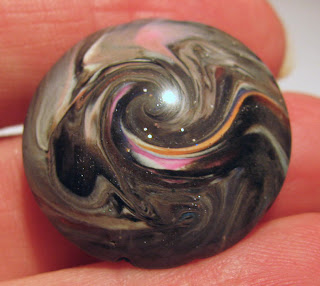


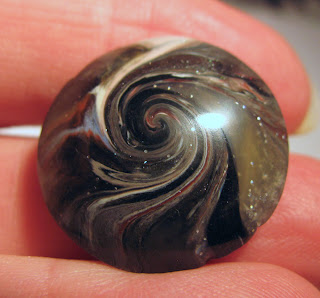


Saturday, September 29, 2012
Design for Impact - Scrap Clay Process
In any artform the artist wants her/his work to be noticed, to grab the attention of the viewer, and to do that it must have impact. In my experience, one of the best ways to get that effect is to use the design element of value and to combine it with the design principle of contrast. Those together create tremendous impact. The greater the contrast between the values, the stronger the impact. To demonstrate this I'll explain my scrap clay spiral lentil bead process. I'm going to use scrap clay that is mainly within a narrow value range even though the colours will differ quite a bit from each other. I'll add a small amount of high contrast black and white and, hopefully, you'll see what I mean.
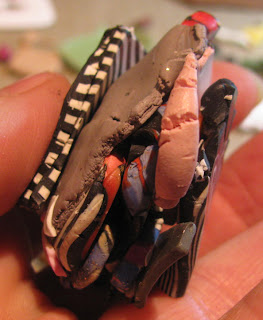
I start with a pile of scrap, thick pieces rolled fairly flat, canes sliced open and rolled flat. Grab individual pieces and stack them on top of each other randomly.
Roll this stack flat, tear in half, stack, tear in half again, stack, roll out again. Look at the edges you retain when you tear the clay rather than folding and rolling or cutting and rolling.
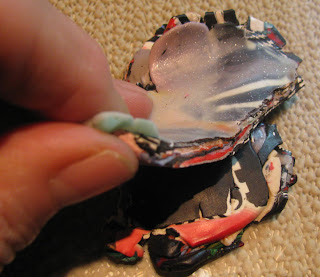
The beauty of polymer clay is that it retains the original colours even though stacked and rolled several times, just as it does when you make a cane that you repeatedly reduce.
As the sheet becomes more homogeneous and greys out, these edges pull brilliant colour and strong contrast back into the sheet, and that's what I use to make the spiral lentil beads. I now tear the sheet into bead-sized pieces, making sure I get some of these edges and embedded edges into each piece, then it's time to fold the sheet into undulating folds, keeping as much of the edges visible as you want.



This bead has some interesting edges showing, but there is a fairly large, bland part, and that won't translate into a spiral pattern, so you can cut int the bead in the boring area and the undulations will reveal more edges interestingly patterned.
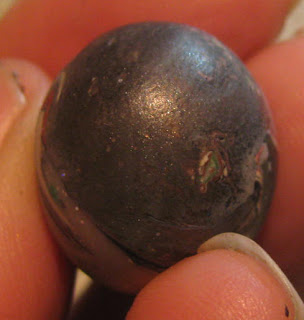

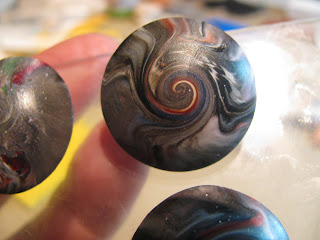
(click on pictures for larger images)
I start with a pile of scrap, thick pieces rolled fairly flat, canes sliced open and rolled flat. Grab individual pieces and stack them on top of each other randomly.
Roll this stack flat, tear in half, stack, tear in half again, stack, roll out again. Look at the edges you retain when you tear the clay rather than folding and rolling or cutting and rolling.
The beauty of polymer clay is that it retains the original colours even though stacked and rolled several times, just as it does when you make a cane that you repeatedly reduce.
As the sheet becomes more homogeneous and greys out, these edges pull brilliant colour and strong contrast back into the sheet, and that's what I use to make the spiral lentil beads. I now tear the sheet into bead-sized pieces, making sure I get some of these edges and embedded edges into each piece, then it's time to fold the sheet into undulating folds, keeping as much of the edges visible as you want.
This bead has some interesting edges showing, but there is a fairly large, bland part, and that won't translate into a spiral pattern, so you can cut int the bead in the boring area and the undulations will reveal more edges interestingly patterned.
The result is a related batch of interesting beads, even though the overall blends are grey. The interest comes primarily from the colours and contrast found at the edges. These are raw, so I'll bake them tomorrow and sand and buff and show the final beads. You can imagine how interesting your beads would be if you were selective in using scrap that included metal leaf, glitter, metallic clays, etc.
Silk Purse Bracelet - Using Scrap Clay
Silk Purse Bracelet
I'm working on the process of creating interesting spiral lentil beads from scrap clay. The fact that they are made from scrap clay makes them difficult to control and therefore difficult to reproduce. I've been working on a technique - actually, I've noticed that I have a way of working with scrap clay that gives me specific results, results I really enjoy. Ergo, I've been paying better attention to what it is that I do when I work with scrap clay. I have a real problem using up scrap clay as, well, as scrap! When I start mixing up the scrap I go through stages where it surprises me with the beautiful, serendipidous juxtaposition of colours and patterns that appear. I have been known to tuck the sheet away when it gets to a particularly gorgeous state or to bake it up as colour studies for future work both in clay and in painting.
Baked colour inspiration, both sides.
Because of this, contrary to many clay artists, I have a serious lack of scrap clay. I'm at the stage where I really hesitate to touch it for fear of using up bits that would contribute to the next batch of unexpected beauty!!! Yes, I know, crazy, right?
The silk purse necklace, previously posted, and now this silk purse bracelet were both made from two different (but related) batches of scrap clay. So I'm now starting to understand how to control this wild process and even how to make sure I get certain effects that I specifically want.
Study the Silk Purse Bracelet beads below and tomorrow we'll talk about one of the most important elements of design for impact.

Study the Silk Purse Bracelet beads below and tomorrow we'll talk about one of the most important elements of design for impact.
Thursday, September 27, 2012
Selling the Sizzle!
Hiroki, The Dragon Lady, on display
http://www.claymagination.blogspot.ca/2012/03/sculpted-polymer-clay-relics.html
http://www.claymagination.blogspot.ca/2012/03/sculpted-polymer-clay-relics.html
I'm sure some of you feel the way I do after presenting my work - it's the most unpleasant part of the creative process!!! I'm exhausted and unsettled even though things went extremely well and most of the collection was accepted and even applauded (I've included a couple of pictures from their window display). I guess that's why many artists have agents. That having been said, I recognize the need for good marketing strategy and, yes, I want my work to be seen, and it does feel wonderful when someone appreciates a piece to the point where they will pay to own it.
So with that in mind, let's talk a bit about how to "value-add" to the actual work of art.
Selling the Sizzle
My husband was a marketing executive. Early in his career his boss took him out for lunch. The first steakhouse they came to was known for its excellent food and there were several people inside, enjoying lunch. They walked on to a second steakhouse which also had a good reputation. Here the steaks were cooked in a glassed-in area so the chef was visible to both the diners inside and people passing by on the street. The place was packed. His boss asked, "What's the difference? Both have great steaks." He then dropped this gem: "The first place sells great steaks. This one sells great steaks and it also sells the sizzle!"
This powerful lesson has been translated into the marketing of my art, both paintings and jewelry.
The key is The Story - the story behind the birth of the piece..... the story about the artist..... the story about the process itself. People enjoy hearing about these stories, and so often, when purchasing a work of art, the buyer is also buying a bit of the artist. Knowing what led the artist to make that particular piece, knowing a bit of the history of the artist, her/his quirks, foibles, needs, knowing a bit of the process of the creation or of the material from which it's made, this gives the buyer inside information that she/he can share with those who notice their purchase. It's called "selling the sizzle". It makes the piece more than just a visual experience. It enlarges it, giving it history, connections, reasons for being, even an aura of mystery with hints of even more to know.
How to value-add? One simple but very effective way is to include a little write-up about the piece with the piece. For example, each of the pieces in this collection has a specific, personalized write-up, including the name of the piece as well as a bit of background on the medium itself and on the experience of the artist (me). At the back of the little folder I have cut two slits so I can insert my business card. Not only does this give the potential buyer "the story", but it makes it easier and more interesting for the sales staff to present the piece to their shoppers. Furthermore, it becomes a more interesting item to buy as a gift for someone else.
Mine are all handmade. The inside is printed on my printer for easier reading, but each is personalized to the specific piece of jewelry. This is a choice I've made (over having it professionally produced) because of my feelings about "the mark of the artist", discussed in an earlier post. That's why I also make my own clasps to the extent possible. I want as much of each piece to be handmade by me as can reasonably be done.
So I encourage all of you to consider "selling the sizzle" along with your art.
Now let's talk pricing. Another unpleasant facet, but necessary and therefore dealt with. I decide how much I need to get out of the piece including material cost and reasonable labor costs. I don't include prototyping because that is very time consuming and the most enjoyable part of the process for me. Coming up with a new creation, whether a new technique for surface veneer or new shapes or new connections is what I love to do and would do over and over and over again. Having made the prototype (and having worn it to make sure I have worked out all the kinks) I then make a second. That gives me a realistic idea of how much time is involved. On that basis I work out a reasonable wholesale price, then double it and look at it from the standpoint of whether I, as a buyer, would consider spending that amount of money to acquire that specific piece. If it is way too high, I look at ways I can change the production of it to make it more reasonable. If it is not possible to do that, I don't make any more of that type of art.
It is important to differentiate between one-of-a-kind and reproducible pieces. I have chosen to position myself as a one-of-a-kind artist and as such I charge more for my work. I'm willing to put myself into a smaller buyer pool, knowing that, in time, my work will prove itself unique, interesting, well-made, and that this reputation is what will fuel future purchases.
Tuesday, September 25, 2012
Village Queen Necklace - Designing with Asymmetrical Balance
The Village Queen Necklace in sunlight and in shade
I'm presenting my Fall Collection today so I'm a little frazzled. This necklace has been gestating in my head for quite a while now. It's been a real pain! I've come to realize that when my creative side resists something, it's because my ideas are not true to me. Yes, this is all about faking it: faux amber (mix of old and new techniques), ivory (my version), onyx (thanks to Carol Blackburn's wonderful book on PC Beads) stone (mine), red coral (definitely mine, but that's a whole other tale to tell!!!) and quartzite (also mine), but I finally realized I didn't want to make a "simulated" natural stone necklace. Remember, it's important for me to leave the mark of the artist. I want people to know that it can't possibly be just another assembled stone necklace. I want them to say, "Hey, wait a minute - there's something not quite....... hmmmmm......... let me move in closer and get a better look......."
I have much more to say, but I'll get back to this after the presentation. In the meantime, here are the close-ups:

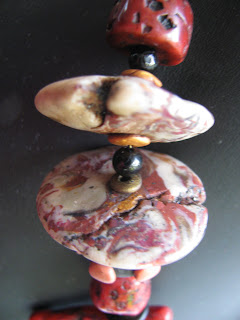


I'm presenting my Fall Collection today so I'm a little frazzled. This necklace has been gestating in my head for quite a while now. It's been a real pain! I've come to realize that when my creative side resists something, it's because my ideas are not true to me. Yes, this is all about faking it: faux amber (mix of old and new techniques), ivory (my version), onyx (thanks to Carol Blackburn's wonderful book on PC Beads) stone (mine), red coral (definitely mine, but that's a whole other tale to tell!!!) and quartzite (also mine), but I finally realized I didn't want to make a "simulated" natural stone necklace. Remember, it's important for me to leave the mark of the artist. I want people to know that it can't possibly be just another assembled stone necklace. I want them to say, "Hey, wait a minute - there's something not quite....... hmmmmm......... let me move in closer and get a better look......."
I have much more to say, but I'll get back to this after the presentation. In the meantime, here are the close-ups:
Subscribe to:
Posts (Atom)
